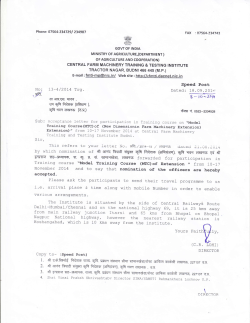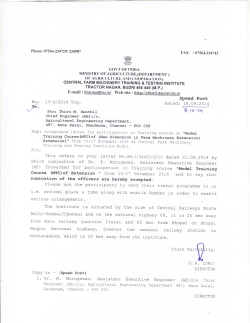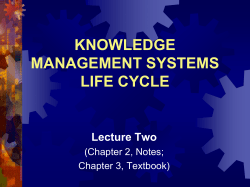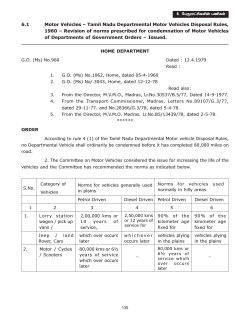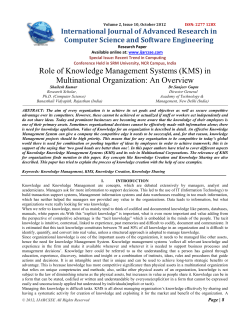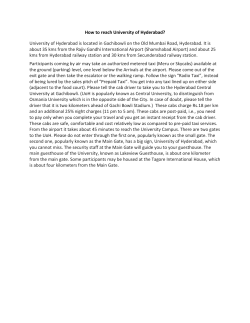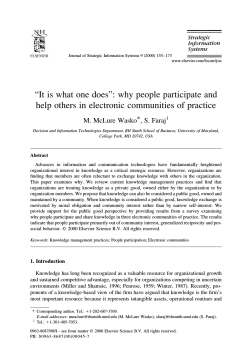
WHY IS IT THAT A KNOWLEDGE MANAGEMENT INITIATIVE WORKS OR FAILS
WHY IS IT THAT A KNOWLEDGE MANAGEMENT INITIATIVE WORKS OR FAILS Carlsson, Sven A., Informatics, School of Economics and Management, Lund University, Ole Römers väg 6, SE-223 63 Lund, Sweden, sven.carlsson@ics.lu.se Kalling, Thomas, Informatics, School of Economics and Management, Lund University, Ole Römers väg 6, SE-223 63 Lund, Sweden, thomas.kalling@ics.lu.se Abstract In this paper we evaluate a KMS-enabled KM initiative in a Swedish MNC. Using the concept of “Net Benefits” as our dependent variable we describe and explain why a KMS-enabled knowledge sharing initiative worked in some plants and failed in some other plants of the same firm. The study is divided into two parts. The first is quantitative and aims to outline, 1) whether knowledge sharing has occurred, 2) the effects of knowledge sharing on cost items and price, and 3) the effects on profit. The statistical findings imply that the following phases must be accomplished, 1) knowledge sharing through the use of the KMS, 2) managing the conversion of knowledge, and 3) improving profit margins. Using a qualitative case study we derived analytically eight factors, associated with different phases, appearing to distinguish between success and failure in sharing knowledge and converting it into financial performance: 1) the local perception of the sharing initiative, 2) aspiration and strategic ambitions, 3) the view on internal competition, 4) the view on the nature of the knowledge shared, 5) initiative management and control, 6) local communication, 7) the ability to manage the strategic implications of learning, and 8) corporate control mechanisms. Keywords: Knowledge Management, Knowledge Management System, Knowledge sharing, Evaluation study 1 1 INTRODUCTION Some strategic management scholars state that the only sustainable competitive advantage is effective and efficient organizational knowledge management (Grant, 1996). The concept of creating, coding, storing, sharing, integrating, and using knowledge in organizations is not new, but management practice has become increasingly more knowledge-focused. Recent interest in organizational knowledge has prompted the issue of how to manage knowledge to an organization’s benefit and with regard to the use of Knowledge Management Systems (KMS) for managing knowledge. Generally, Knowledge Management (KM) refers to identifying and leveraging the individual and collective knowledge of an organization to support that organization in becoming more competitive. Edwards et al. (2003) in their editorial paper for the journal Knowledge Management Research & Practice (KMRP) outline key directions for KM research and practice. In the words of Edwards et al.: ”… an underlying assumption of KM … is that a firm’s competitive advantage to a large extent flows from its unique knowledge and how it manages knowledge”, but “… too little empirical evidence exists to show that this assumption is true” and “… research could address the question of what is the strategic value of knowledge. Related to this is that KM research in general should produce ever more detailed answers to the question of why a KM initiative works for whom and in what circumstances.” (ibid.) We attempt to shed some light on two of the issues stressed by Edwards et al. by an evaluation study of a KMS-enabled KM initiative. A general goal when designing and implementing a KM initiative is that it should lead to increased performance. The construct “increased performance“ forces attention to the dependent variable(s). The aim of our research is to focus on the “Net Benefits” of a KM-initiative and what Critical Success Factors and processes in the specific context led to the (desired) outcome. The remainder of the paper is organized as follows: the next section briefly presents and discusses KM and KMS evaluation research, pointing out the need for addressing “Net Benefits” in evaluation research. It is followed by a presentation of our research approach. In Section 4 our case study is presented. In the last section we discuss our findings and suggest further research. 2 KM AND KMS EVALUATION RESEARCH This is a study of a KMS-enabled KM initiative in SCA Packaging (SCAP). The aim (desired outcome) of the KM initiative was sharing of manufacturing knowledge to improve operations and performance. SCAP’s KM-initiative was influenced by KM, process management (PM), and the quality movement. These theories and ideas are used increasingly in organizations as means for improving performance (Scott & Cole 2000, Benner & Tushman 2003). PM is based on a view of organizations as systems of interlinked processes and “…involves concerted efforts to map, improve, and adhere to organizational processes.” (Benner & Tushman 2003). PM is underpinned by KM and learning perspectives. In process management, KMS are increasingly used for enabling and enhancing knowledge sharing of process knowledge. Our study of SCAP’s KM-initiative was done as an evaluation research study. In the Information Systems (IS) field, IS evaluation and IS evaluation research have been stressed as critical means in advancing the field (Bjørn-Andersen & Davis 1988); and Edwards et al. (2003) argue that evaluation of KM initiatives and KMS implementations are critical means in advancing the KM field. Generally, KM and KMS evaluation is concerned with the evaluation of different aspects of real-life interventions in the social life where KM and KMS are critical means in achieving the interventions’ anticipated and desired goals. The aim of KM/KMS evaluation research is to produce ever more detailed answers to the question of why and how a KM/KMS initiative works for whom and in what circumstances. Evaluation research must address “the dependent variable” (outcome, result, etc.). At the first International Conference on Information Systems (ICIS), Keen discussed what was needed to make 2 MIS into a coherent research field and defined three main needs. One was “Definition of the dependent variable”. In the words of Keen: ”What is the dependent variable? Until we have a coherent definition of "information" we have nothing to measure. Surrogates for improved information, such as user satisfaction or terminal hours of usage, will continue to mislead us and evade the issue of a theory of information for MIS.” (Keen 1980). In part as a response to Keen’s call for defining the dependent variable DeLone and McLean (1992) developed their “Information systems success model”. This model has been used in hundreds of research works that have applied, developed, challenged, or validated the original model. Based on research progress and technological and organizational, change, DeLone and McLean recently reviewed, evaluated, and updated their model (DeLone & McLean 2002, 2003). Figure 1 depicts their updated success model. Figure 1. The updated IS success model (DeLone & McLean, 2003, p. 24) DeLone and McLean argue that ”… more field-study research should investigate and incorporate “Net Benefits” measures.” (DeLone & McLean 2003). To paraphrase Keen: using surrogates like “user satisfaction” and “usage” measures is not an acceptable alternative to measuring performance (Net Benefits) directly. Focusing on Net Benefits means a more macro-oriented focus and addressing the transformational impact of information technology and IS (Agarwal & Lucas 2005). In our study this means that we seek to describe and explain how a KMS-enabled KM initiative actually is affecting the studied organization’s performance. In our evaluation study we will use DeLone and McLean’s model, but we will primarily focus on “Net Benefits” and we will complement the underlying “variance-study view” of their model with more recent thinking in organization studies. Our study is influenced by recent thinking in organization studies, where studies are problem-driven and oriented toward events unfolding in the world (Davis & Marquis 2005). The focus is on social mechanisms which are “sometimes-true theories” providing “an intermediary level of analysis inbetween pure description and storytelling, on the one hand, and universal social laws, on the other” (Hedström & Swedberg 1998). Said Davis and Marquis: “If a regression tells us about a relation between two variables—for instance, if you wind a watch it will keep running—mechanisms pry the back off the watch and show how. Mechanisms describe “a set of interacting parts—an assembly of elements producing an effect not inherent in any one of them. A mechanism is not so much about ‘nuts and bolts’ as about ‘cogs and wheels’ . . . —the wheelwork or agency by which an effect is produced” (Hernes 1998, p. 74).” (Davis & Marquis 2005). Problem-driven research “…is distinguished by its orientation toward explaining events in the world, beginning with the question, `Why is it that …?´” (Schoonhoven et al., 2005). In our case: why is it that a KMS-enabled knowledge sharing initiative works or fails. 3 3 RESEARCH APPROACH This is an evaluation study of a KMS-enabled KM initiative in SCA Packaging (SCAP). The aim, desired outcome, of the KM initiative was sharing of manufacturing (process) knowledge to improve operations and performance. Due to the lack of research on “Net Benefits” of KM-initiatives and what Critical Success Factors (CSF) and processes lead to Net Benefits—see, for example, Edwards et al. (2003)—we to a large extent used an inductive approach, but we were influenced by current KM and KMS theories, primarily theories on knowledge sharing, for example, the work of Nonaka and Takeuchi (1995) and Newell et al. (2000) Hence, we accept that the empirical findings are partly gathered, presented and “coloured” by contemporary KM-theories. Yin’s (1994) “pattern-matching” method of analysis was applied, whereby we from the empirical patterns of the case generated our results in the form of CSF and process descriptions linked to outcomes (dependent variables). 3.1 Research design The study is divided into two parts. The first is quantitative and aims to outline, generally in SCAP, 1) whether knowledge sharing (learning) has occurred, 2) the effects of sharing (learning) on cost items and price, and 3) the effects on profit. Here, we used reported data on the relative development of machine speed (SPEED: average machine speed over the year), direct productivity (DIRPROD: average direct labour/unit of output over the year) and waste (WASTE: annual waste as proportion of purchased raw material) from the 38 plants between 1996-2001, for one type of machine (the only type existing in 38 plants, out of 200 plants). In here lies the assumption that knowledge sharing has occurred: improving machine speed, direct productivity and waste levels is the result of plant efforts to absorb knowledge from sister plants and central knowledge repositories and libraries. We then studied the correlations between these machine performance indicators with profit and loss data to check the relations between accomplished knowledge sharing and financial performance. Operating margin (MARGIN), and price (PRICE), total cost (TOTCOST), raw material cost (RAWMTRL), and labour cost (LABOUR) were selected, the latter four measured in terms of average per unit of output. After having studied the general links between sharing success and financial performance, certain patterns became evident. In order to study them further and address “why the KMS-enabled KMinitiative worked or failed”, six plants with different degrees of success were singled out for onsite case studies (in the UK, Germany, Sweden and Belgium). The issue then largely became to track the local success and failure factors, throughout different stages of the causal chain. At each plant we interviewed the general manager, the production manager, the sales manager, a supervisor, and an operator. Interviews were semi-structured, including both closed questions and open questions to ensure exploration. We also conducted interviews with representatives of top management, including the initiative manager. In total, 34 interviews were made. To strengthen reliability, we used interrating (by fellow researchers) in instances where accounts were unclear, as well as respondent validation (Van de Ven & Poole 1990). 4 EVALUATION OF THE SCAP KM-INITIATIVE The reported case describes a corporate-spanning knowledge sharing initiative initiated in SCAP in 1997. The objective of the initiative is to spread best practices throughout the plants. The 38 plants (profit centers) are located in Ireland, the UK, France, Italy, Switzerland, Germany, Belgium, the Netherlands, Denmark and Sweden. The knowledge inherent in the initiative is absorbed both internally (from knowledgeable plants) and externally (from the field of science, consultants, alliance partners, machine suppliers etc.), and is continuously growing and updated. Knowledge may be articulated as production methods and procedures, or as recommendations, suitable under certain conditions. Methods are documented in memos, reports and in knowledge repositories, accessible over the corporate intranet and direct distribution. In total, the “library” of methods includes thousands of 4 documents on advice on machine maintenance, machine optimisation, scheduling principles and so on. Three basic outputs are measured per machine: average machine speed, direct productivity and waste; these results are reported monthly from plants to the head office. Plants who want to improve a particular aspect of production can find knowledge about how to do it, by consulting the corporate data bases and production methods library, or consult directly a knowledgeable sister plant or an expert at corporate level. Each machine team sets targets annually, and follow up their performance relatively regularly. Benchmarking is made feasible, and plants who want to improve performance on a particular machine can easily track sister plants across Europe who are performing well on that type of machine, and approach them for their experience and solutions. Successful machine teams are awarded annually, on the basis of their improvements, at an award ceremony attended by top management and runner-up machine teams. The KM-initiative is administered centrally, by a technical department, including technical experts as well as one data administrator. At plant level, the production manager is normally responsible for internal communications and the performance. The presentation of findings is structured in accordance with the two-fold approach to the case. 4.1 Quantitative Assessments The first question, whether there had been sharing, was operationalised as to whether the measured production performance had been improved. Figures 2 and 3 indicate that there were improvements both in machine speed and in productivity. Overall, plants improved machine speed by 16% between 1996 and 2001. In terms of labour hours per unit of output, plants increased productivity by 16%. Figure 4 also shows that waste levels have been reduced during 1996-2001. Machine speed 150 140 130 120 1996 1997 1998 1999 2000 2001 Figure 2. Machine speed development 1996-2001 (y axis not crossed at zero) Labour hours per unit of output 0,55 0,50 0,45 0,40 0,35 0,30 1996 1997 1998 1999 2000 2001 Figure 3. Productivity (inverted) development 1996-2001 (y axis not crossed at zero) 5 8,4 Waste percentage 8,2 8,0 7,8 7,6 7,4 7,2 1996 1997 1998 1999 2000 2001 Figure 4. Waste percentage 1996-2001 (y axis not crossed at zero) These descriptive statistics indicate that some progress has been made in the three areas that were aimed to be improved as a consequence of the knowledge sharing initiative. If we allow performance metrics like this to be indicative of learning (cf. Epple et al. 1991), we can argue that sharing, learning, has taken place. It is also noteworthy that there seems to be a limit to improvement. All three measures indicate a reversal rate of learning for the plants that have been part of the exercise longer. What, then, are the implications on financial performance? The correlations between the manufacturing performance indicators and profit and loss data are exhibited in Table II, which describes the correlation between relative development of SPEED, DIRPROD, WASTE, and financial variables (adjusted for currency rates and inflation) between 1996 and 2001. TABLE II: Correlations, relative developments 1996-2001 SPEED PROD WASTE PRICE TOTCOST RAWMTRL LABOUR SPEED DIRPROD -0,642 *** WASTE -0,559 *** 0,473 ** PRICE -0,068 0,202 0,147 TOTCOST -0,137 0,262 0,263 0,954 *** RAWMTRL -0,223 0,265 0,273 0,756 *** LABOUR -0,217 0,341 * 0,228 0,901 *** 0,932 *** 0,534 *** MARGIN 0,283 -0,318 -0,423 ** -0,361 * -0,620 *** -0,079 0,657 *** -0,562 *** n=38 While SPEED, DIRPROD and WASTE are strongly correlated internally, only WASTE is associated with margin development. Direct productivity and speed are not connected with the development of profitability, even if the development of direct productivity is associated with improved labour costs. The tendency is rather that improved machine speed, direct productivity and waste management are associated with cost improvements—and price reductions, even if the statistics are not significant. It is only waste management that seems to pay off in financial terms: for speed and productivity it appears that price reductions offset cost improvements, meaning there is no effect on profit. Which can be interpreted as a failure of the initiative, unless one allows for the interpretation that market prices of boxes have declined thus forcing cost cutting and hence the levelling out of profitability improvements. We studied the correlations between the absolute figures for the seven variables on a year by year basis, and the tendency was the same. Bar waste, speed and productivity levels are correlated with low cost and price levels. Based on the statistical analysis, this relation can be based on price reductions due to a lack of customer-perceived quality (due to a narrower product offering or to “lean” quality management routines at plants) or to a limited awareness of how to price accurately given an improved cost base. 6 These findings seem to signal that while there might be successful knowledge sharing, this does not necessarily mean that performance is improved. For instance, as indicated by the study of the effects of speed increases, costs may well go down, but price may decrease as well, meaning there is no effect on margin. The statistical findings imply that organisations embarking on a knowledge sharing venture need to accomplish the following phases: 1. Sharing of knowledge. As measured here, on a corporate level, SCAP was successful in improving average waste performance, machine speed and direct productivity. However, not all units were successful in absorbing and implementing new methods. So, one phase to deal with in the sequence of events concerns the management of the sharing as such. 2. Cost or Price improvements. Overall, in those cases where production performance was improved, there generally was an improvement in certain cost items (albeit with limited statistical significance). However, not all plants were successful in this respect. Thus another managerial phase concerns the conversion of successful sharing into improved costs or quality (manifest in better prices or sales volume). 3. Profit improvements. However, as supported by the statistical findings, even if individual profit proxies such as labour cost per unit of output are improved, this does not necessarily mean margin improves. Machine speed and direct productivity improvements are associated with cost improvements – and price reductions. This implies that yet a third managerial phase concerns the conversion of individual cost or price improvements into profit. So, knowledge sharing is not automatically “good”. The factors that hamper or drive the process need to be understood, hence the six onsite case studies. 4.2 On Site Case Studies The six plants singled out for case study differed from each other in terms of success in the knowledge sharing initiative. Plant 1 and Plant 2 did not improve their production performance between 1996 and 2001. Plant 3 did improve production, but failed to convert it into costs or sales improvements. Plant 4 improved certain costs, but not profit margin, which plants 5 and 6 actually managed to do. As derived analytically from the plant case studies, eight factors appear to distinguish between success and failure in sharing knowledge and converting it into financial performance: 1) the local perception of the sharing initiative, 2) aspiration and strategic ambitions, 3) the view on internal competition, 4) the view on the nature of the knowledge shared, 5) initiative management and control, 6) local communication, 7) the ability to manage the strategic implications of learning, and 8) corporate control mechanisms. These will be discussed in accordance with each of the three managerial phases discussed above. Table III illustrates which phase plants have accomplished and which type of factors that are associated with each phase. TABLE III: Phase factors and plant accomplishments Process Phase Accomplished 0 1 2 Factors 1-6 2, 8 Plant no. 1, 2 3 4 3 7, 8 5, 6 Phase 1: Managing Sharing The first issue, to make sure that knowledge is shared and converted into improved production performance, appeared to be affected by factors 1 to 6. Plants 1 and 2, which failed, indicated difficulties in these areas, while the other plants did not. For instance, the local perception of the sharing initiative varied. Out of the ten respondents, none expressed a positive attitude to the initiative or argued that it had or could have a positive impact. 7 Representatives claimed that the sharing initiative “does not sufficiently address the different local circumstances” (general manager). They also claimed that the initiative has been “misunderstood and misused”, that “it is merely a section of the annual productivity budget” (production manager). A general manager stated that ”we are not ready for it yet, but it fits our volume strategy well”. Underlining the alienated perception of the initiative, one respondent put forth that “the worker of the year approach doesn’t fit our culture”. In contrast, the successful plants (plants 3-6), indicated a slightly different perception. They focused more on the knowledge provided by the initiative, and the possibilities of the benchmarking setup. “It is a knowledge base that has helped us survive over these years” (general manager). “It is a library of methods” (production manager). “The concept of sharing knowledge is very good, and we also try to use it in our communication with customers” (sales manager). Respondents also indicate that the initiative has become integral in day-to-day routines. “Generally, the initial buzz is gone. It is institutionalised now. It is not just a tool, it is a way of living” (production manager). “It has helped us develop team spirit, it is in the minds of the workforce” (operator). The second factor, referring to local aspirations and strategic ambitions, also appear to discriminate between the plants. As described by one general manager: “We have other priorities here at the moment, like developing our customer base. The advice is important, but obviously I am not familiar with it. I don’t think we need that production knowledge today”. Another general manager says “We don’t have time. We are not active enough, definitely not.” These plants also exhibit an inability to implement new methods. A supervisor: ”Whenever we try to change things here, there are obstacles prolonging implementation. Things simply die, and so does motivation”. ”I don’t know of anybody who has been trained on how to use the intranet” (supervisor). Representatives of the more successful plants give a slightly different picture. ”Even with the knowledge and experience that I have, I sometimes find radical solutions in the initiative. It surprises you, and you never get too much knowledge” (production manager). ”I am deeply involved in working with taking in new methods” (general manager). ”We now have screens at each of the machines, where they can access the intranet. Each team also has formal gatherings where they exchange knowledge. A third factor refers to view on internal competition. Because the sharing initiative included knowledge repositories of both methods and performance results, and because there were annual awards, a sense of competition emerged. This existed previously as well, locally, between shifts in the plants. The weaker plants did not see competition as an incentive, partly because they were too far from being best in the corporation at the outset. ”Playing in Division three you don’t really think about Premier League”. “Many of our guys have given up competing”, (production manager), partly because they claim to have interests other than winning competitions: ”We’re not driven by being best, we have to make good results, period” (general manager). ”There is always someone somewhere who has better possibilities and knowledge than we” (supervisor). On the positive side, an operator stated that ”competition is good in the sense that it makes people here wanting not to be the worst”. Conversely, more successful plants embraced internal competition. ”The people’s perception of competition is important, and here it is not so strong that it has negative effects” (general manager). “The transfer initiative means we can now compete on a constructive basis across the company” (supervisor). However, plant-internal competition is still important: ”We compete with ourselves in relation to last year and we compete between shifts” (supervisor). ”We have made great use of the internal competition, between shifts and so on” (general manager). Underlining the ease with which certain units approach competition, workers at a plant located in the former East Germany say: “In Eastern Germany we are used to socialistic competition. We are used to be benchmarked and compared, and to setting targets and making plans. It is not new to us, we did it in the old days as well”. The fourth organisational issue, relating to the view on the nature of the shared knowledge, shows some interesting differences. Part of the purpose of the sharing initiative is to articulate, make explicit, knowledge about certain work routines. However, it appears that less successful plants perceive production knowledge to be more tacit and difficult to articulate, than do successful plants – they do not trust the articulated knowledge to be the only means to decide work routines. ”There is a large 8 proportion of tacit knowledge than cannot be taught or transferred” (supervisor). ”There are many variables, each machine has its own quirky bits” (operator). “We have a complex process that we cannot write down. There are many parameters to think of. We once tried to list all the parameters to consider but it is impossible” (general manager). Successful plants take a different view. ”There is a certain tacit component but I want to break it down.” (production manager). ”We wrongly believe it to be a form of art rather than bringing it closer to science. Some of it is art but we overplay that” (production manager). ”Quite a lot could be written down. We can improve by writing things down” (supervisor). Successful plants also address motivational factors. ”Motivation drives learning here” (operator). ”There is a tacit component, and then you need motivation to be able to take it in” (production manager). Initiative management and control, a fifth factor, also differed between successful and less successful plants. The initial idea of the central initiative management was that, at least, plants should set oneyear plans for each machine outlining waste, speed and productivity targets, and then monitor and feed back progress with some regularity. Their ambition was that production managers should be involved in the local assessments, if not the general manager. The intention was also that local plants should have creative meetings and forums for discussion about methods and ways to proceed. The less successful plants did do less in this respect than others. “I am involved in the planning exercise only, once a year. I never discuss these figures explicitly with my boss but we do discuss productivity quarterly” (general manager). “We don’t display performance figures on the notice board nowadays” (production manager). “I have meetings with key operators an hour every three weeks where we might cover it” (production manager). ”I look at the figures quarterly and focus on highlights. I go through it with the production manager then too” (general manager). ”We don’t really discuss the figures explicitly, we used to but not anymore. The initiative is on the backburner” (supervisor). Successful plants have managed it differently. ”I follow it up daily and have meetings with key staff three times a week when we discuss it. Monthly I go through it with all staff” (production manager). ”I communicate daily with operators and they really react upon it. I have daily meetings about downtime, overproduction and so on. The planning exercise is dealt with rigorously with shift leaders and the teams. We follow it up monthly, and have broken down annual targets into quarterly to get better control” (production manager). ”Within the shifts we talk about it when new data is displayed. All workers know about the performance” (operator). “I interact with operators on a daily basis” (general manager). A sixth factor refers to plant-internal communication of results and implications. It appears that the less successful plants sense an urge to improve communication of what is being done and achieved within production to other stakeholders. Improvements of activities other than production appear to be perceived as potentially conflicting with productivity improvements. ”Sometimes, the production figures are interpreted by people who do not have the whole picture” (production manager). ”There is too much focus on productivity, you cannot forget the market side” (general manager). ”We must communicate better with Sales”. ”We need to communicate it better with customers” (sales manager). ”We need to communicate better across plants” (supervisor). Production too is seen as lacking in understanding of the initiative implications. ”We must communicate better with the production people, they don’t understand it very well here. They must understand that this is something that makes things easier for them” (supervisor). Communication is less of an issue with the more successful units. No one suggests that communication is a problem. ”I am involved on a monthly basis or if there is an ad hoc debate about something between sales and production” (sales manager). “We are informed about our production performance and if it suits our purposes we will communicate it one way or another to our customers” (sales manager). Phase 2: Managing the Conversion of Knowledge Plant 3, successful in taking on new knowledge, actually failed to convert it into cost or sales improvements. Relating it to the eight overarching managerial factors, aspirations and strategic ambitions, as well as corporate control mechanisms explain a large proportion of plant differences. 9 In relation to aspiration and strategic ambition, one issue in plant 3 is that they lack the incentive provided by a competitive market. Their profit levels have always (for decades) been high, albeit declining due to recent market entries and price cuts. Sales volume has declined as well. The plant strategy has not been based on low-price, low-cost, but on a higher degree of differentiation. “I try to make sure that we sell by helping our customers in serving their customers, rather than just offering a low price. But the market is changing and prices and margins are going down, so the limbo metaphor is clear. We need to improve costs in the near future, and we will have to do it without jeopardising quality. If there is a price reduction it is down to market conditions, not our quality. There is no relation between production performance and quality”. “It is not as competitive here as elsewhere, and the growing low frills segment is driving price averages down. And we are not best on that.” (sales manager). “Our variable costs are high, and we are worse than some” (general manager). “The market change has forced us to look at business we are not so good at making, in order to fill the capacity” (production manager). Plant 3 has been relatively slow in cost reductions such as material costs rationalisations and job redundancies to cut labour costs. “We have made a few people redundant over the years, but it has been through natural recession, which keeps morale up. The market has been a bit difficult here over the last three years due to a declining economy. And people are aware we will have to make changes to the cost base, but that we will do it in a natural way. They mustn’t feel under threat, because we will have morale problems. But if we don’t improve, competitors will take our jobs away” (general manager). Plants that did convert production performance into financial improvements were more focused on making the necessary changes. One general manager says “we were in a position where we had to make redundancies. There was no other way we could have survived. It is not nice. And we also had to do a lot of changes with our working capital base, cutting stock and so on”. As long as the market could be perceived as calm, there was no immediate hurry to cut costs and improve margin further. With high margin levels, much higher than most of the sister plants in the corporation, the incentives to work harder were less significant. One respondent claimed “yes, the thermostat has been switched off here for some years”. Corporate head office, which controls business units mainly through one or two financial targets in relation to budget (corporate control mechanisms), felt no urge to alter or extend target variables, as long as units delivered according to budget. There was no measuring of whether improved production performance actually was linked to cost reductions. Phase 3: Improving Profit Margins The third and final concern is to be able to make sure that improvements in costs (or sales) are not offset by other costs or by declining prices. Plant 4 was successful in keeping labour and other costs down, but also experienced declining price levels. The ability to manage the strategic implications of learning as well as corporate control mechanisms are factors explaining some of the differences between successful and non-successful plants. While plant 4 succeeded well with both production performance and cost reductions, they also suffered from declining price levels. Three or four different explanations were offered by respondents. One explanation was that increased production performance not only reduced costs but also prices through reduced customer-perceived quality. Less physical quality and service quality, and a narrower product scope could explain the lower price levels. However, respondents claim this is not the case in their plant, and they view cost and quality as completely independent from each other. ”In fact, if anything, cost reduction and quality improvements are positively related” (production manager). “There is no connection with price” (sales manager). A second explanation could be that sales people simply give away cost cuts to customers through lowered prices. With a set margin target, a cost reduction could be the means by which sales people increase order intake and volume – without improving margins unless there are significant scale advantages. ”If there is a fight on the market you might give things away” (general manager). ”We give some things away. There is no connection at all between our production efficiency and bad quality. If the sales guys understand there is a cost reduction of anything, it is already in their heads and they start to talk about it and will give it away” 10 (sales manager). Yet a third explanation could be that causalities are reversed, that overcapacity on markets force prices down, and that price “giveaways” are responses to market forces. For this particular plant, market prices did not decline, indicating that price reductions were caused by “giveaways”. “If there is a fight on the market, you might use a part of your cost winnings to cut prices. But it has to be controlled within the strategy frames” (sales manager). A fourth potential explanation could be leakage of knowledge to competitors, or that competitors, one way or another, are able to replicate the cost cuts. Although it is difficult to assess due to data access, SCAP respondents claim they know of no migration of personnel. Furthermore, they had not displayed the methods or performance information to outsiders such as consultants, even if there are obvious risks that certain customers inform competitors. “We did the same mistake some years ago, when we started to make public and give away productivity gains to selected customers” (sales manager). The explanatory factors just presented could partly be described as an ability to manage the strategy implications of learning. The two plants that did not offset cost reductions saw the initiative as part of the strategy, and used it to improve their product market performance. ”Price implications is not an issue here. It could be both ways. But I don’t see a conflict between the transfer initiative and sales activities. That’s why the whole plant has to work as one team, which we have dealt with by making sure that both sales and production have the same, interdependent objectives” (general manager). ”We decide on quality first, then we optimise speed and all the other stuff” (sales manager). ”Price management is prioritised here, even if low-cost is our main priority” (sales manager). “We have grown our volume with twenty percent since 1996, and kept our price levels up while cutting total costs by ten percent. That would have been impossible without the transfer initiative” (general manager). One factor that could stimulate the ability to deal with the strategic implications is the corporate control mechanisms. Extensions of the performance targets to include metrics that compare production improvements with profit improvements would have been welcome, according to some respondents. One general manager for a plant successful in terms of profitability says: “As some plants are not really forced to cut costs and so on, it could be a point. Some may have had too good a life. I can see some additional metrics added to the measuring, as weights in the overall assessments of plants and managers”. In the absence of such mechanisms, plant management uses their own incentives. “We have internal awards both for successful production people and sales people that manage to increase sales. Organisationally, sales and production have to be coordinated. None can benefit at the expense of the other, it is logically impossible. The coordination is absolutely core to the strategy” (sales manager). 5 DISCUSSION, CONCLUSION AND FURTHER RESEARCH We set out to describe and explain why is it that a KMS-enabled knowledge sharing initiative works or fails. We also argued that knowledge sharing is a means to an end, and decided to focus on “Net Benefits”. Our study explains why some of the plants did not use the KMS. For example, argued some of the personell in the non-using plants that the KM-initiative was not for them, they had other more critical issues to address. Among the non-users there were also concerns regarding “system quality” and “information quality”. We assumed and observed that knowledge sharing through the use of a KMS does not necessarily lead to improved margins. The major contribution of the study is the description and explanation of how some, but not all, of the plants using the KMS turned use into “cost or process improvements”. Even fewer plants were able to turn the “cost or process improvements” into “profit improvements”. The study suggests that contextual factors are critical in getting value from KMS investments. We proposed different tasks or stages in these processes and listed, theoretically and empirically, factors that influence the success in different stages. 11 The final conclusion is that researchers need to view knowledge sharing through the use of KMS as a means, not an end, to whatever purposes organisations might have for sharing knowledge. If the purpose is financial, strategic, the ultimate effect to look for is improved profit margins or competitive advantage—successful sharing is just the first step in a causal process that is far more complex than the immediate cognitive contingencies indicate. In terms of future research, there are plenty of opportunities, considering the increasing popularity of KM and KMS. Depending on accessibility, researchers should be able to apply both quantitative and qualitative methods and use both case approaches and larger samples. Statistical data about for instance performance might be difficult to get access to. But it appears important to be able to study not just sharing obstacles, but also the link with performance, if one is interested in “Net Benefits” of KM and KMS investments. References Agarwal, R. and H.C. Lucas, Jr. (2005). The information systems identity crisis: focusing on highvisability and high-impact research. MIS Quarterly, 29(3), 381-398. Benner, M.J. and M.L. Tushman (2003). Exploitation, exploration, and process management: the productivity dilemma revisited. Academy of Management Review, 28(2), 238-256. Bjørn-Andersen, N. and G.B. Davis (Eds.)(1988). Information Systems Assessment: Issues and Challenges. North-Holland, Amsterdam. Davis, G.F. and C. Marquis (2005). Prospects for organization theory in the early twenty-first century: institutional fields and mechanisms. Organization Science, 16(4), 332-342. DeLone, , W.H. and E.R. McLean (1992). Information systems success: the quest for the dependent variable. Information Systems Research, 3(1), 60-95. DeLone, , W.H. and E.R. McLean (2003). The DeLone and McLean model of Information Systems success: a ten-year update. Journal of Management Information Systems, 19(4), 9-30. Edwards, J.S, Handzic, M., Carlsson, S. and M. Nissen (2003). Knowledge management research & practice: visions and directions. Knowledge Management Research & Practice, 1(1), 49-60. Epple, D., Argote, L. and R. Devadas (1991). Organisational learning curves: a method for investigating intra-plant transfer of knowledge acquired through learning by doing. Organization Science, 2(1), 58-70. Grant, R.M. (1996). Toward a knowledge-based theory of the firm. Strategic Management Journal, 17 (Winter Special), 109-122. Hedström, P. and R. Swedberg (1998). Social mechanisms: An introductory essay. In Social Mechanisms: An Analytical Approach to Social Theory (Hedström, P. and R. Swedberg, Eds.), Cambridge University Press, Cambridge, 1-31. Hernes, G. (1998). Real virtuality. In Social Mechanisms: An Analytical Approach to Social Theory (Hedström, P. and R. Swedberg Eds.), Cambridge University Press, Cambridge, 74-101. Keen, P.G.W. (1980). MIS research: reference disciplines and a cumulative tradition. Proceedings of the First International Conference on Information Systems, 9-18. Newell, S., Robertson, M., Scarbrough, H. and J. Swan (2002). Managing Knowledge Work. Palgrave, Basingstoke, Hampshire, UK. Nonaka, I. and H. Takeuchi (1995). The Knowledge Creating Company. Oxford University Press, Oxford, UK. Schoonhoven, C.B., Myer, A.D. and J.P. Walsh (2005). Pushing back the frontiers of organization science. Organization Science, 16(4), 327-331. Scott, W.R. and R.E. Cole (2000). Introduction: the quality movement and organization theory. In The Quality Movement & Organization Theory (Cole, R. and W. Scott, Eds.), Sage, London, xiii-xxix. Van de Ven, A.H. and M.S. Poole (1990). Methods for studying innovation development in the Minnesota innovation research program. Organization Science, 1(3), 313-335. Yin, R.K. (1994). Case Study Research: Design and Methods. Second Edition. Sage, Thousand Oaks. 12
© Copyright 2025
